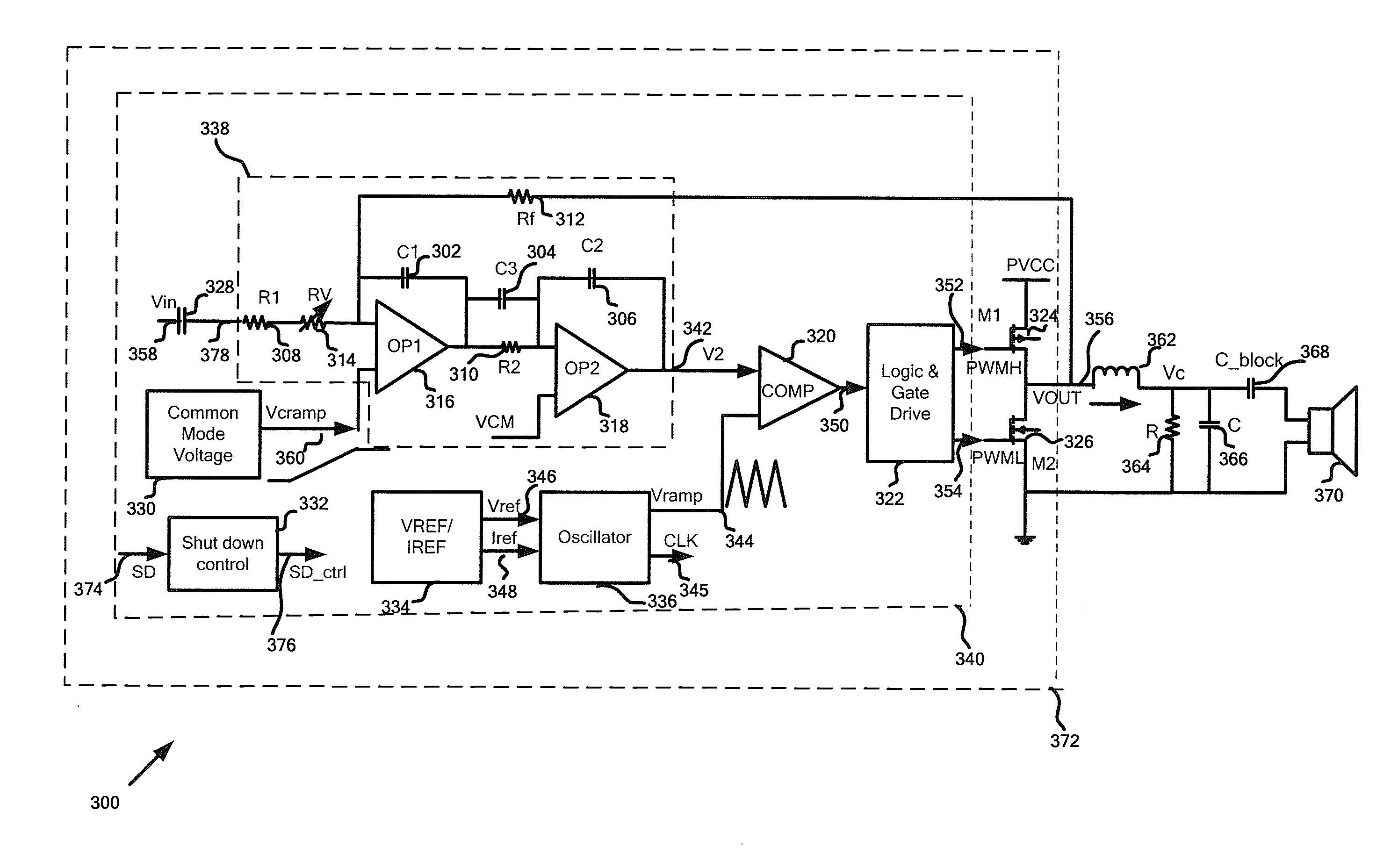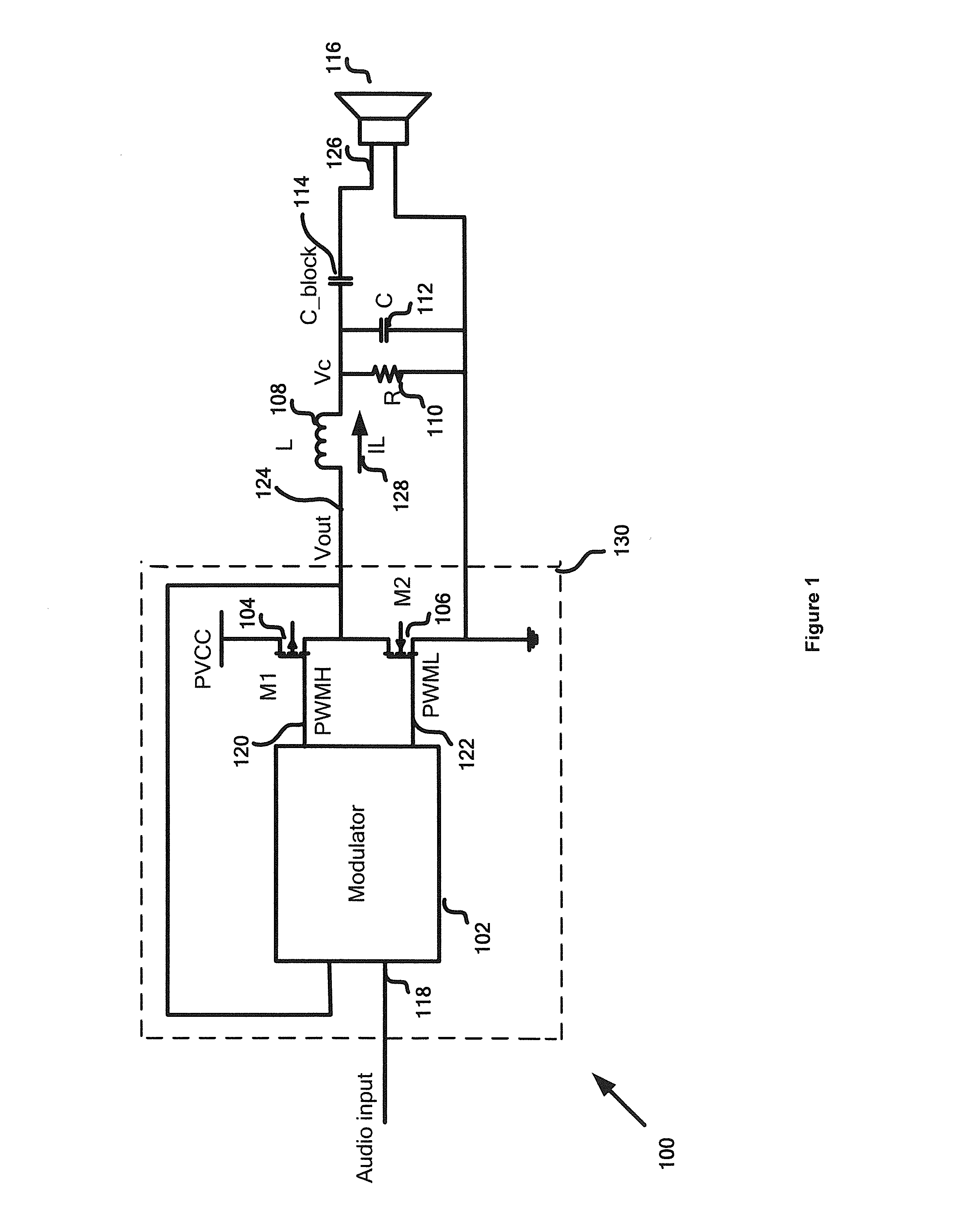[0019]According to one embodiment, a system for amplifying an input signal to generate an output signal includes a current generator, an oscillator, and a comparator. The current generator is configured to receive a first voltage signal, process information associated with the first voltage signal and a first reference signal, and generate a first current signal based on at least information associated with the first voltage signal and the first reference signal. The oscillator is configured to receive at least the first current signal and a second reference signal, and to generate a second voltage signal based on at least information associated with the first current signal and the second reference signal, the second voltage signal being associated with a modulation frequency. The comparator is configured to receive the second voltage signal and a third voltage signal, and to generate a modulation signal related to the modulation frequency based on at least information associated with the second voltage signal and the third voltage signal, the third voltage signal being related to at least the input signal, the first voltage signal, and a feedback signal, the feedback signal being associated with the output signal. Additionally, the first current signal decreases if the first voltage signal increases in magnitude. The modulation frequency decreases if the first current signal decreases in magnitude. For example, the first current signal increases in magnitude if the first voltage signal decreases in magnitude, and the modulation frequency increases in magnitude if the first current signal increases in magnitude.
[0020]According to another embodiment, a system for amplifying an input signal to generate an output signal includes a signal detection component, a signal selection component, a current generator, an oscillator, and a first comparator. The signal detection component is configured to receive the output signal and to generate a first reference signal. The signal selection component is configured to receive the first reference signal and a first voltage signal, and to generate a selected signal based on information associated with the first reference signal and the first voltage signal. The current generator is configured to receive the first reference signal and the first voltage signal, process information associated with the first reference signal, the first voltage signal and a second reference signal, and generate a first current signal based on at least information associated with the first reference signal, the first voltage signal and the second reference signal. The oscillator is configured to receive at least the first current signal and a third reference signal, and to generate a second voltage signal based on at least information associated with the first current signal and the third reference signal, the second voltage signal being associated with a modulation frequency. The first comparator configured to receive the second voltage signal and a third voltage signal, and to generate a modulation signal related to the modulation frequency based on at least information associated with the second voltage signal and the third voltage signal, the third voltage signal being related to at least the input signal, the selected signal, and a feedback signal, the feedback signal being associated with the output signal. Further, the first current signal decreases if the first voltage signal increases in magnitude. The modulation frequency decreases if the first current signal decreases in magnitude. For example, the first current signal increases in magnitude if the first voltage signal decreases in magnitude, and the modulation frequency increases in magnitude if the first current signal increases in magnitude.
[0021]According to yet another embodiment, a method for amplifying an input signal to generate an output signal includes receiving a first voltage signal, processing information associated with the first voltage signal and a first reference signal, and generating a first current signal based on at least information associated with the first voltage signal and the first reference signal. Additionally, the method includes receiving at least the first current signal and a second reference signal, processing information associated with the first current signal and the second reference signal, and generating a second voltage signal based on at least information associated with the first current signal and the second reference signal, the second voltage signal being associated with a modulation frequency. Furthermore, the method includes receiving the second voltage signal and a third voltage signal, processing information associated with the second voltage signal and the third voltage signal, and generating a modulation signal related to the modulation frequency based on at least information associated with the second voltage signal and the third voltage signal, the third voltage signal being related to at least the input signal, the first voltage signal, and a feedback signal, the feedback signal being associated with the output signal. Moreover, the first current signal decreases if the first voltage signal increases in magnitude. The modulation frequency decreases if the first current signal decreases in magnitude. For example, the first current signal increases in magnitude if the first voltage signal decreases in magnitude, and the modulation frequency increases in magnitude if the first current signal increases in magnitude.
[0022]According to yet another embodiment, a method for amplifying an input signal to generate an output signal includes receiving the output signal, processing information associated with the output signal, and generating a first reference signal. The method further includes receiving the first reference signal and a first voltage signal, processing information associated with the first reference signal and the first voltage signal, and generating a selected signal based on information associated with the first reference signal and the first voltage signal. Additionally, the method includes receiving the first reference signal and the first voltage signal, processing information associated with the first reference signal, the first voltage signal and a second reference signal, and generating a first current signal based on at least information associated with the first reference signal, the first voltage signal and the second reference signal. Furthermore, the method includes receiving at least the first current signal and a third reference signal, processing information associated with the first current signal and the third reference signal, and generating a second voltage signal based on at least information associated with the first current signal and the third reference signal, the second voltage signal being associated with a modulation frequency. Moreover, the method includes receiving the second voltage signal and a third voltage signal, processing information associated with the second voltage signal and the third voltage signal, and generating a modulation signal related to the modulation frequency based on at least information associated with the second voltage signal and the third voltage signal, the third voltage signal being related to at least the input signal, the selected signal, and a feedback signal, the feedback signal being associated with the output signal. The first current signal decreases if the first voltage signal increases in magnitude. The modulation frequency decreases if the first current signal decreases in magnitude. For example, the first current signal increases in magnitude if the first voltage signal decreases in magnitude, and the modulation frequency increases in magnitude if the first current signal increases in magnitude.
[0023]Depending upon embodiment, one or more benefits may be achieved. These benefits and various additional objects, features and advantages of the present invention can be fully appreciated with reference to the detailed description and accompanying drawings that follow.
 Login to View More
Login to View More  Login to View More
Login to View More 


